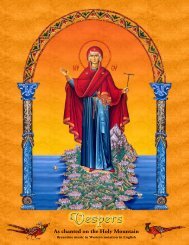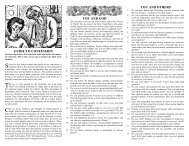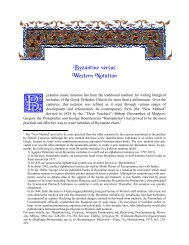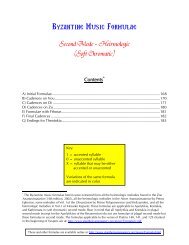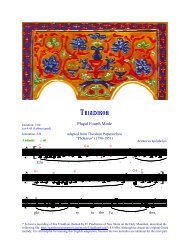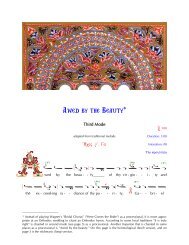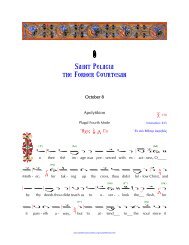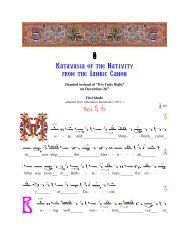Reading Psalmodia (PDF) - St. Anthony's Monastery
Reading Psalmodia (PDF) - St. Anthony's Monastery
Reading Psalmodia (PDF) - St. Anthony's Monastery
You also want an ePaper? Increase the reach of your titles
YUMPU automatically turns print PDFs into web optimized ePapers that Google loves.
) For downward movement:Apostrophos uApostropheElaphron i LightYporrhoi o CascadeHamili p Lowc) For no movement:Ison w Leveld) Combined signs for larger intervals:Seventh up @ down #Octave up C down $Ninth up í down pCombinations are created in the same way for still larger intervals, though in <strong>Psalmodia</strong>these are very rare.The Execution of Interval SignsBesides indicating the interval the voice is to move, the Interval Signs also indicate themanner in which the note is to be sung:Unless otherwise indicated (eg by a time-sign) each note is one rhythmic beat in length.[The Cascade is a notable exception: the Yporrhoi instructs us to sing two successivenotes, each a second lower than the preceding note. Each note of the Cascade is a singlerhythmic beat in length.]The <strong>St</strong>ep [ w ], the Flutter [e ] and the Double <strong>St</strong>itch [r ] all indicate a rise of a second.The <strong>St</strong>itch [t ] indicates a rise of a third when written below or after a <strong>St</strong>ep [c wt], butif written above the <strong>St</strong>ep or the Flutter [ ; A ] combines with that note to indicate a riseof a fourth.The Leap [y ] of itself indicates a rise of a fourth, but is only found in combination.Written above the middle or end of a <strong>St</strong>ep or a Flutter, it combines to indicate a rise of afifth, written above the beginning of a <strong>St</strong>ep or Flutter, a rise of a sixth.The Apostrophe [u ] indicates a fall of a second.The Light [ i ] indicates a fall of a third.10




